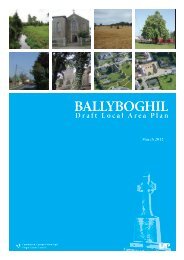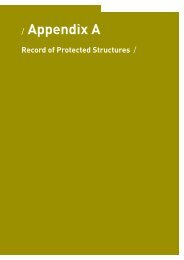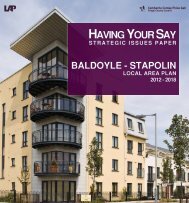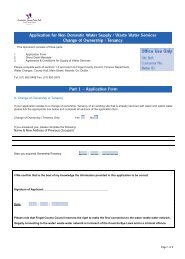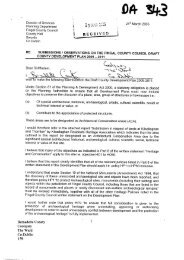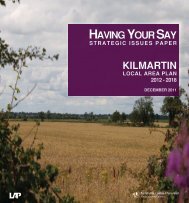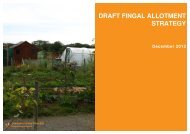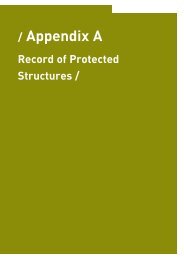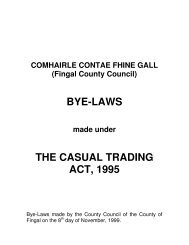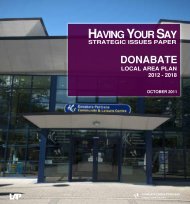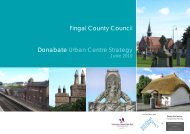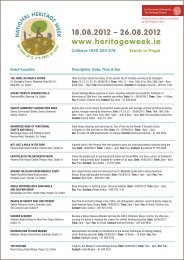Field Monument Advisor Leaflet - pdf - Fingal County Council
Field Monument Advisor Leaflet - pdf - Fingal County Council
Field Monument Advisor Leaflet - pdf - Fingal County Council
You also want an ePaper? Increase the reach of your titles
YUMPU automatically turns print PDFs into web optimized ePapers that Google loves.
The <strong>Field</strong> <strong>Monument</strong><br />
<strong>Advisor</strong> Scheme<br />
This scheme has been initiated by the Heritage <strong>Council</strong> and<br />
<strong>Fingal</strong> county <strong>Council</strong>. The job of the <strong>Field</strong> <strong>Monument</strong> <strong>Advisor</strong><br />
is to support landowners and provide information about the<br />
various archaeological monuments on their land. The purpose<br />
is to assist landowners to preserve and protect archaeological<br />
monuments in their landscape.<br />
If you farm or own land in <strong>Fingal</strong> and require information on<br />
archaeological monuments or recently discovered artefacts<br />
contact your <strong>Field</strong> <strong>Monument</strong> <strong>Advisor</strong>, Christine Baker.<br />
<strong>Fingal</strong>’s Archaeological Heritage<br />
<strong>Fingal</strong> has a wealth of archaeological monuments spread<br />
throughout the county, from mounds and tombs to castles and<br />
churches. The archaeology of <strong>Fingal</strong> dates from the earliest<br />
period and extends over thousands of years from flint scatters<br />
and stone axes to ringforts, mill races and demesnes.<br />
Archaeology reflects all aspects of human existence and<br />
contains irreplaceable information about how the people of<br />
the <strong>Fingal</strong> region lived, worked and died.<br />
Contacts<br />
> <strong>Fingal</strong> <strong>Field</strong> <strong>Monument</strong>s <strong>Advisor</strong><br />
Christine Baker<br />
T. 01 870 4455<br />
M. 087 915 8440<br />
Christine.baker@fingalcoco.ie<br />
> <strong>Fingal</strong> Heritage Officer<br />
Gerry Clabby<br />
T. 01 890 5697<br />
Gerry.clabby@fingalcoco.ie<br />
> If an archaeological site is found, contact:<br />
National <strong>Monument</strong>s Section<br />
Department of Environment,<br />
Heritage & Local Government<br />
T. 01 888 3109<br />
nationalmonuments@environ.ie<br />
> If an archaeological object or human<br />
remains are found, contact:<br />
National Museum of Ireland<br />
T. 01 677 7444<br />
Ask for the Duty Officer<br />
<strong>Fingal</strong> <strong>Field</strong><br />
<strong>Monument</strong><br />
<strong>Advisor</strong> Scheme
What is Archaeology?<br />
Archaeology is the study of past people through their monuments,<br />
sites and artefacts. Some monuments such as mounds, castles,<br />
crosses and churches are highly visible. Others such as barrows,<br />
ringforts, walls and enclosures may only be traced as low<br />
earthworks on the ground. Still more have been levelled by<br />
hundreds of years of landuse and may only be visible as<br />
cropmarks on aerial photographs or through geophysical survey.<br />
Where Can I Find Out About<br />
Archaeological Sites?<br />
The Record of <strong>Monument</strong>s & Places (RMP) is the statutory list of<br />
all known monuments (about 700) in <strong>Fingal</strong>. It consists of<br />
Ordnance Survey maps with the recorded monuments marked by<br />
circles and is accompanied by a list detailing the exact position<br />
and classification of each monument. The RMP is available to view<br />
at the Planning Public Counter of <strong>Fingal</strong> <strong>County</strong> <strong>Council</strong> (Swords &<br />
Blanchardstown), Local Libraries and can also be accessed<br />
through the Department of Environment, Heritage & Local<br />
Government’s website www.archaeology.ie. Archaeological<br />
<strong>Monument</strong>s and Places are protected by the National <strong>Monument</strong>s<br />
Acts 1930-2004.<br />
How Can I Recognise<br />
Archaeological Sites?<br />
New discoveries are frequently being made in <strong>Fingal</strong> often by<br />
farmers and landowners. Ploughing can bring artefacts such<br />
as flint, pottery tiles, human and animal bone to the surface. It<br />
can also highlight areas of blackened or stony soil which may<br />
indicate burning. Sub-surface features such as walls and<br />
ditches can lead to differences in cereal crop growth with<br />
stunted growth or early ripening. There may also be local<br />
traditions or names associated with certain fields or springs.<br />
How to Care<br />
for Archaeological<br />
<strong>Monument</strong>s<br />
> Be aware of the locations of monuments<br />
on your land.<br />
> Ensure contractors/employees know the<br />
position and size of sites and are aware that<br />
it is important not to damage them.<br />
> Leave upstanding monuments as islands in<br />
cultivated ground and protect with a minimum<br />
margin of 5m-7m.<br />
> Minimise plough depths and avoid use of<br />
sub-soilers, mole-ploughs and spiking.<br />
> If possible put levelled or crop-mark sites<br />
into pasture.<br />
> Control growth of gorse and scrub-cut at base and<br />
treat stump-and avoid tree planting in the vicinity<br />
of a monument as root action can cause damage.<br />
> Maintain correct stock levels to prevent<br />
poaching or erosion of monuments.<br />
> Place feeding troughs, land drainage works<br />
and access tracks away from monuments.<br />
> Contact the National <strong>Monument</strong>s Service or<br />
the National Museum of Ireland if you discover<br />
ancient objects or structures.<br />
Activities<br />
to Avoid<br />
> Do not use historic buildings such as<br />
castles, churches and even old farm<br />
buildings to shelter livestock.<br />
> Avoid ground disturbance or landscaping<br />
of archaeological sites.<br />
> Do not remove material from or add<br />
material to sites.<br />
> Avoid tracking machinery across or near<br />
sites (especially after rain).<br />
> Do not carry out burning on or in the<br />
vicinity of monuments.<br />
> Avoid deep ploughing over levelled or<br />
cropmark sites.<br />
> Do not uproot gorse, trees or scrub by<br />
their roots.<br />
> Do not pull ivy from buildings.<br />
> Do not embark on the clean up of graveyards<br />
without archaeological advice.<br />
> Avoid removing field boundaries, gateposts,<br />
stiles and old farm buildings.




